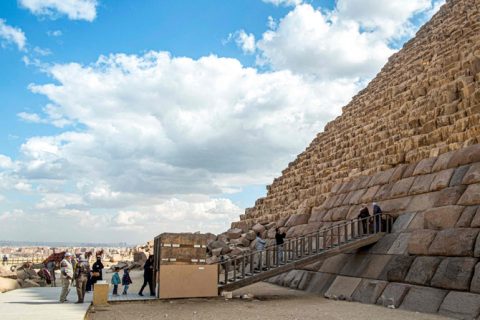Egyptian authorities represented by Mostafa Waziri, the secretary general of Egypt’s Supreme Council of Antiquities, recently revealed plans for the implementation of a one-of-a-kind project dubbed the “Project of the Century”.
Led by a coalition of Egyptian and Japanese experts, the project seeks to resurface the Pyramid of Menkaure with the granite blocks that once clad part of its exterior. The pyramid of Menkaure is the smallest of the three main pyramids of the Giza pyramid complex, which is located on the Giza Plateau in the southwestern outskirts of Cairo.
The pyramid was probably built sometime in the 26th century BC using limestone and Aswan granite to serve as a tomb for Menkaure, the fifth or the sixth king of the 4th dynasty of Egypt. Menkaure was reportedly the son and probably the successor of Khafre.
The first sixteen courses of the pyramid’s exterior were made of red granite while the upper portion was cased in the normal manner with Tura limestone. Part of the granite was left in the rough.
The Pyramid of Menkaure’s original height was 65.5 meters. However, it is currently 61 meters tall with a base of 108.5 meters. Its angle of inclination is approximately 51°20′25″. Also, according to Waziri the pyramids’ structure is currently encased by “five or six layers” of granite blocks, but it once had at least 16.
The timelines of the project to restore the pyramid of Menkaure

According to the secretary general of Egypt’s Supreme Council of Antiquities, the coalition will begin the execution of the Project of the Century with at least a year of study. An international team will then decide whether to proceed with the restoration of the hundreds of granite blocks that once covered roughly the bottom third of the pyramid.
Overall, if the project proceeds it is set to be completed within a span of three years. Noteworthy, the Project of the Century is part of a larger initiative to develop the Giza Pyramids area which is home to the Grand Egyptian Museum, also known as the Giza Museum. The latter is an archaeological museum that is set to be the world’s largest with 81,000 m2 of floor space.
Despite its grandeur, plans for the Project of the Century have faced significant backlash from experts and the public in general. For example, prominent archaeologists and experts have expressed serious concerns over the feasibility of the project, citing the nature of the rocks used and international archaeological restoration law.
Critics also argue that the unpolished and incomplete nature of the granite blocks makes reconstruction unworkable and the international restoration principles dictate that the style of a monument should be kept unchanged.
Also Read
The 870,000 Square-Meters Grand Egyptian Museum Is Scheduled To Open This Year.
Penn Museum to begin renovations on its Ancient Egypt and Nubia Galleries

